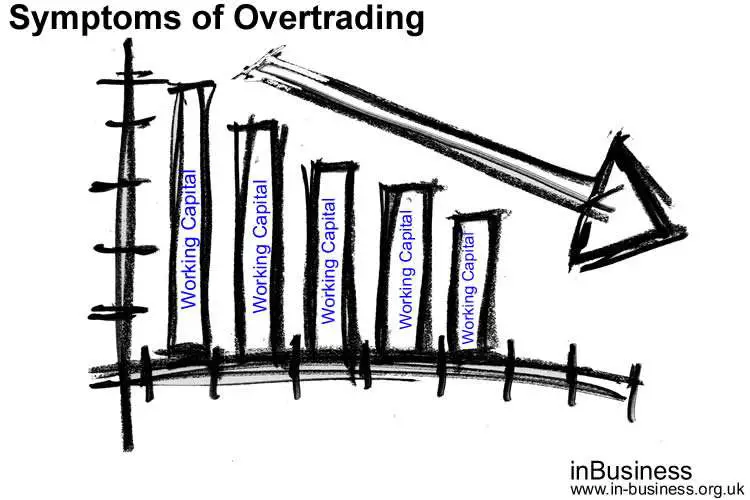Symptoms of Overtrading

This article is about the symptoms of overtrading, which is most often seen as a business startup problem. However, overtrading can affect mature businesses too.
Before I go into the symptoms of overtrading, it is worthwhile looking at the definition of overtrading first.
Overtrading business definition…
Overtrading occurs when a company expands its operations too quickly. Companies which overtrade encounter liquidity problems and can eventually run out of working capital (or cash). This is where a company is doing more business than the finances will allow. Often-times overtrading can result in companies going out of business.
Overtrading is a symptom of not collecting monies due from customers in-time to satisfy the company’s outgoings. This can occur when a business offers more favourable credit terms to its customers that it receives from its suppliers.
An overtrading company can and often is a profitable business. But as many entrepreneurs will tell you, cash is king in business.
What are the symptoms of overtrading?
Symptoms of overtading include the following:
1. Having to borrow money to get through each month of trading

Many companies need to dip into an overdraft where they have one. Also, borrowing money for long-term requirements and capital additions is normal. However, when a business is constantly borrowing to stay afloat, this is a warning sign.
As already mentioned above, overtrading companies are mostly profitable, so where the monthly management accounts show a profit, but more money is being borrowed each month…this is a sure sign of overtrading.
2. Increased debtor days is another of the signs of overtrading…
Debtors days is a ratio measurement used by companies to see how quickly cash is being collected from its debtors. The higher the debtors days, the longer it is taking to collect debtors.
So where the debtor-day ratio is increasing, this is a signal that something is wrong. To avoid an increase in debtor days, a company must keep a tight control on its customer payment terms. However, a lack of control in this area of a business is a sure way to lead to overtrading and bad cash flow.
3. Low gross profit margins are a symptom of overtrading…
Businesses with a high turnover are not necessarily a good bet. The old saying ‘Turnover is vanity, profit is sanity’ still holds true.
One of the signs of overtrading is where a business has a high turnover, but where the gross profit margins are low. A business with low gross profit margins has to work extremely hard to meet operating expenses, and where there is also a delay in money collections too, this is potential for serious overtrading.
4. Unhappy suppliers having to wait for payment and having suppliers on stop…
Another of the signs of overtading is where a company is having difficulty in meeting supplier payment terms. Where supplier accounts are on stop, this is an indication that something is going wrong.
This is especially true of a business which is making good profits, and yet has no ready-cash to pay its supplier accounts on time.
5. A significant change in the company’s current ratio

Current ratio (or working capital ratio) is a liquidity ratio that measures a company’s ability to pay short-term and long-term obligations as they fall due.
Current ratio is calculated as Current Assets / Current Liabilities
Usually a current ratio of less than one is not a good sign, as this means that a company’s current liabilities exceed its current assets.
However, a high current ratio, or one that is increasing significantly, is not necessarily a good sign.
This is especially true where the current asset which increases significantly is trade debtors.
What are the remedies of overtrading?
Now that we’ve looked at the causes of overtrading and symptoms to watch out for, let’s take a look at the remedies of overtrading.
1. Enforcing better payment terms with customers
As discussed above, one of the causes of overtrading is not collecting trade debtors on time. But also, having customer payments terms which are worse than supplier payment terms.
In order to reverse this situation, the business must review its customer payment terms. The payment terms of customers should be either equal to or better than the terms offered by suppliers.
Once the new payment terms have been set with customers, these must be strictly monitored and enforced.
2. Negotiate better payment terms with suppliers
In addition to improving customer payment terms, a company should always try to negotiate better supplier payment terms too. This is essentially like obtaining ‘free-finance’.
Depending upon the payments terms adopted with customers, as discussed above, the payment terms for the main suppliers should be at least equal to these terms.
If existing supplies are not willing to extend payment terms, consider switching to another suppler who will provide better terms.
3. Scale-back business growth

One of the top signs of overtrading is where a business is expanding too quickly. This type of aggressive growth plan is likely to lead to overtrading, especially where there is an imbalance between payment terms of customers vs suppliers.
Scaling-back on this aggressive growth plan will ease the stress on working capital, and allow the cash flow to catch up. Reduce marketing spend and be more realistic over customer acquisition. By scaling-back growth, this will allow the company time to negotiate the necessary payment terms discussed above.
4. Look at ways to ease cash flow
One of the ways to ease cash flow, where a business is suffering from overtrading, is to look at leasing assets, instead of buying them. By leasing assets in this way, the cash flow is spread over time, thereby reducing the cash-drain on working capital.
However, this is only a short-term fix to solving overtading, but it will buy some time for some of the other measures to be applied and to take affect.
5. Reduce stock levels
Holding excessive levels of stock for any business, reduces working capital and ties up cash. But for a business suffering from overtrading, having excessive stock will exacerbate the problem.
Reducing stock levels to minimum levels will improve cash flow and help to alleviate overtrading.
6. Arrange long-term finance
Long-term finance is one of the overtrading solutions that should be approached with caution. Borrowing money to provide for short-term working capital over the long-term, without fixing the underlying problem, is dangerous for business.
So before looking to borrow additional funds as a solution to overtrading, make sure a business plan is in place to correct the overtrading problem too.
What are the consequences of overtrading?
The consequences of overtrading include having poor creditworthiness due to having bad payment terms with your suppliers.
The knock-on effect of poor creditworthiness will result in difficulties in raising finance. Where raising finance is one of the solutions to resolve the short-term overtrading situation, this may be a problem.
A lack of funds and working capital could lead to delayed repairs to plant, machinery and vehicles, which could have significant consequences on the business as a whole.
One of the other consequences of overtrading is to have problems with suppliers. This can be time-draining and make running the business inefficient.
The ultimate consequence of overtrading is for the business to go into receivership or liquidation. It’s possible that where is a business is profitable, that a receiver will be able to rescue the business, by negotiating with a new owner who has deeper pockets and is able to provide the necessary working capital to continue.
Finally please social share and comment below…
If you enjoyed reading this article about Symptoms of Overtrading, please share. Choose your favourite social media channel below. I’d also appreciate your comments below too, and thank you for reading in-Business Blog.
Also, if you’d like to discuss symptoms of overtrading on our business forum you can do this here – Business Forum Discussions.